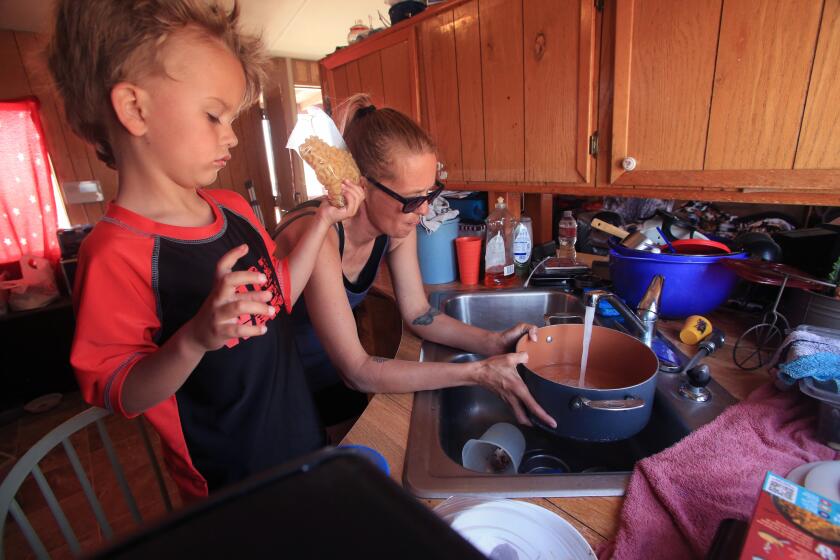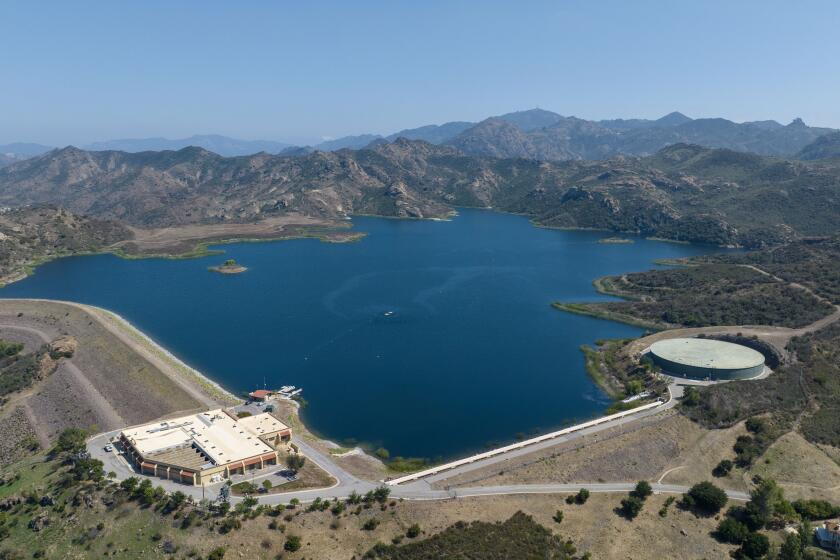
Over the next two decades, Los Angeles County will collect billions more gallons in water from local sources, especially storm and reclaimed water, shifting from its reliance on other region’s water supplies as the effects of climate change make such efforts less reliable and more expensive.
The L.A. County Board of Supervisors on Tuesday adopted the county’s first water plan, which outlines how America’s largest county must stop importing 60% of its water and pivot over the next two decades to sourcing 80% of its water locally by 2045.
The plan calls for increasing local water supply by 580,000 acre-feet per year by 2045 through more effective stormwater capture, water recycling and conservation. The increase would be roughly equivalent to 162 billion gallons, or enough water for 5 million additional county residents, county leaders said.
Aggressive and impactful reporting on climate change, the environment, health and science.
“We need to conserve every drop of water possible for beneficial reuse by reducing demand, by recycling our water, by capturing much more stormwater in our natural aquifers. And I know that the public is watching to make sure we do exactly that,” said Board Chair Lindsey P. Horvath. “As climate change makes our imported water resources less reliable and more expensive, I would like to see the majority of our stormwater be diverted for beneficial reuse rather than washed out to the ocean where it pollutes our coast.”
More than a decade after California passed the Human Right to Water Act, about 1 million residents still lack access to clean, safe, affordable water.
The development of the county’s water plan started in 2019 when former L.A. County Supervisor Sheila Kuehl authored a motion that created the county’s sustainability plan and paved the wave for a water plan.
Horvath, her successor, closed the loop Tuesday on her first day as board chair with her motion to implement the plan. At 41, Horvath is the youngest person to serve as board chair.
Mark Pestrella, L.A. County Department of Public Works director, said pivoting the county from a long history of importing water “is aspirational, but it is actually achievable.”
There are at least 200 independent water districts or agencies in L.A. County responsible for delivering safe, clean water, and Pestrella said the plan was aimed at fostering collaboration.
In 2020, the county asked each for input and also held 90 stakeholder meetings over three years with local and tribal leaders, community members and advocate groups, Pestrella said.
Most of the 200 agencies are on record agreeing to adopt the county water plan.
“For years, we’ve been basically letting each of those any one or a number of those water agencies sort of lead the way or actually just act individually in the interest of the county of Los Angeles,” Pestrella said. The water plan however “has brought all those people together saying what makes sense for this region in terms of our best and highest use of our water.”
The plan will focus on a number of goals: improving the reliability of the region’s water supply; collecting and storing groundwater; increasing the quality and resilience of small systems that are at risk of failing; mitigating the impact of wildfires on the water supply and managing watershed sediment.
The Las Virgenes Municipal Water District is looking to use new technology to harvest fresh water from deep in the ocean.
The county’s water plan, Pestrella said, also sets the county up to be more competitive in applying for state and federal money.
Environmental advocacy groups, such as Heal The Bay and the Natural Resources Defense Council, applauded Tuesday’s move.
“I think I (was in) the very first stakeholder group when this was first formed, and at that time, I admit I was very skeptical of the effort,” said Bruce Reznik, executive director of watchdog group L.A. Waterkeeper. However, he said, the county listened to stakeholders and developed a “a plan I think we can all be really proud of.”
Supervisor Kathryn Barger, whose Fifth District includes Antelope Valley, said L.A. County is mandated by the state to build 90,000 more housing units by 2029 and asked how the plan incorporates that mandate.
Pestrella said it’s built into the plan, but it will require conservation as “an absolute way of life for us to not only maintain our current water supply but to meet the demands you’re describing.”
The supervisors at Tuesday’s meeting stressed how important it was that all residents have access to clean water.
Of the 200-plus water agencies in L.A. County, 11 are failing, 23 are at risk of failing, and 33 are potentially at risk of failing, according to the county water plan. Many of these systems provide water to low-income communities.
Pestrella said the purpose of the plan is not to call out and punish these systems — the state regulates water systems, not the county — but to instead of bring them into the fold and give them resources to improve their systems.
“Full immunity — come out and tell us what your needs are, work with us, don’t hide the problem, put it on the table, there’s actually help,” Pestrella said. “In their defense, I’m sure in the past they’ve asked for help, and they don’t get the help they need.”
After a relatively dry October and November, California has set an initial water allocation of 10% for agencies receiving supplies from the State Water Project.
Supervisor Hilda L. Solis said there must be standards that everyone follows.
The water quality for some residents in the First District, Solis said, which includes East L.A. and many factories, is “least to be desired,” whether that is because of old systems that need to be maintained or because of illegal discharge from industrial areas.
Supervisor Holly J. Mitchell agreed, highlighting residents of Compton and Willowbrook who for years dealt with “putrid groundwater that they paid top dollar for” from the failed Sativa Water District, which suffered poor maintenance and mismanagement. The county’s Department of Public Works assumed full control after the district was dissolved in 2019.
“That shouldn’t happen anywhere,” Mitchell said. “And the regional program that’s being proposed in this plan to identify and support the small potentially at-risk and failing systems will be instrumental in ensuring that nothing like Sativa happens again.”











